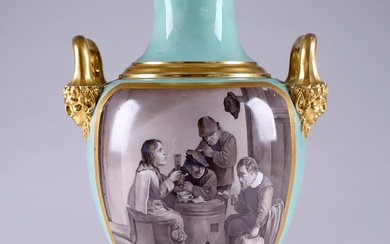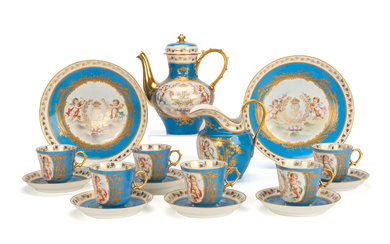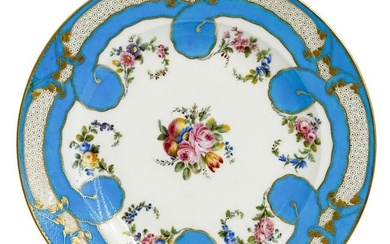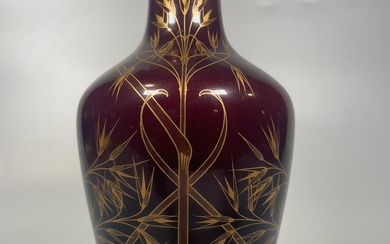Sechs tiefe Teller
Six deep plates
Manufacture Imperiale de Sèvres 1811, 1812
From the "Service à Marly fond nankin frise de lierre coloriée".
Porcelain, painted, gold decoration. Manufacturers mark "M.Imp.Ie de Sèvres 1812", partly painters mark "B", gilders mark. Rubbed in various places, light scratches. D. 23,5 cm.
The plates are from an extensive dinner service made in 1812 by the Manufacture Impériale de Sèvres for Comte Louis Philippe de Ségur. In the Sèvres archives, the service is listed as "Service à Marly fond nankin frise de lierre coloriée", translated Service Marly with nankin fond and colored ivy frieze. A similar service was made by the manufactory in 1815 for Baron Carl von Hardenberg. (Cf. Leprince, Camille / Preaud, Tamara et al,
Napoléon Ier & La Manufacture de Sèvres - LArt de la Porcelaine au Service de lEmpire. 2016, pp. 287 and 292.)
With varying decoration, the service was produced from the early 1820s at the Imperial Porcelain Manufactory of St. Petersburg for the Russian Tsars family, commissioned by Alexander I. (Tsar from 1801 to 1825). After his coronation, his successor Nicholas I (Tsar from 1825 to 1855) had the service substantially expanded with over one hundred place settings for his grand Tsarist palace in Tsarskoye Selo. In the 1850s, the service was moved to the "Belvedere on the (hill) Babigon" near Peterhof Palace, which is why it has been called the "Babigon Service" ever since. The service was still used at the Russian court until the end of the tsarist era, and even after that the manufactory repeatedly produced repeat orders based on the French Sèvres model. Individual pieces are still known from around 1900.
Russia was very much inspired by the French taste since the beginning of the 19th century and it is known that model and decoration designers as well as porcelain painters from Sèvres were called to St. Petersburg. Both in Sèvres and in St. Petersburg, such services of the highest quality of craftsmanship and the finest painting and gold etching were made exclusively for emperors, kings and high-ranking noble personalities.
The Manufacture Impériale de Sèvres existed under Napoleon Bonaparte from 1804 to 1814, he had high quality porcelains made both for himself and as precious state gifts.
Provenance: Noble possession Germany
.schlagwort { color: #999; } .schlagwort:hover { text-decoration: none; }
Estimate
Time, Location
Auction House
Six deep plates
Manufacture Imperiale de Sèvres 1811, 1812
From the "Service à Marly fond nankin frise de lierre coloriée".
Porcelain, painted, gold decoration. Manufacturers mark "M.Imp.Ie de Sèvres 1812", partly painters mark "B", gilders mark. Rubbed in various places, light scratches. D. 23,5 cm.
The plates are from an extensive dinner service made in 1812 by the Manufacture Impériale de Sèvres for Comte Louis Philippe de Ségur. In the Sèvres archives, the service is listed as "Service à Marly fond nankin frise de lierre coloriée", translated Service Marly with nankin fond and colored ivy frieze. A similar service was made by the manufactory in 1815 for Baron Carl von Hardenberg. (Cf. Leprince, Camille / Preaud, Tamara et al,
Napoléon Ier & La Manufacture de Sèvres - LArt de la Porcelaine au Service de lEmpire. 2016, pp. 287 and 292.)
With varying decoration, the service was produced from the early 1820s at the Imperial Porcelain Manufactory of St. Petersburg for the Russian Tsars family, commissioned by Alexander I. (Tsar from 1801 to 1825). After his coronation, his successor Nicholas I (Tsar from 1825 to 1855) had the service substantially expanded with over one hundred place settings for his grand Tsarist palace in Tsarskoye Selo. In the 1850s, the service was moved to the "Belvedere on the (hill) Babigon" near Peterhof Palace, which is why it has been called the "Babigon Service" ever since. The service was still used at the Russian court until the end of the tsarist era, and even after that the manufactory repeatedly produced repeat orders based on the French Sèvres model. Individual pieces are still known from around 1900.
Russia was very much inspired by the French taste since the beginning of the 19th century and it is known that model and decoration designers as well as porcelain painters from Sèvres were called to St. Petersburg. Both in Sèvres and in St. Petersburg, such services of the highest quality of craftsmanship and the finest painting and gold etching were made exclusively for emperors, kings and high-ranking noble personalities.
The Manufacture Impériale de Sèvres existed under Napoleon Bonaparte from 1804 to 1814, he had high quality porcelains made both for himself and as precious state gifts.
Provenance: Noble possession Germany
.schlagwort { color: #999; } .schlagwort:hover { text-decoration: none; }







